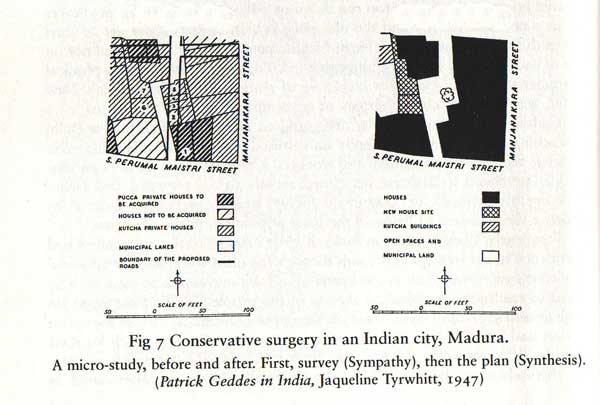

165 conservative surgery
Everyone's heard the phrase 'Think globally, act locally'. Few know it was first said back in 1915, by the Scottish planner and conservationist Patrick Geddes. For Americans who have studied planning or design, the name may ring only a very faint bell. Besides being the father of what we call today regional planning, Geddes was a common-sense, intensely practical thinker who inspired the reclamation of the ancient Royal Mile slums of Edinburgh and created an elegant plan for Dunfermline, paid for by that city's famous son Andrew Carnegie. But his holistic, often profoundly spiritual approach to urban matters made him completely unfathomable to the engineering-oriented Americans. Nevertheless, Geddes is one of the key figures to know. Between 1914 and 1922, Geddes spent a lot of his time in India, and he drew upon his experiences in Edinburgh—a city that once rivalled Calcutta for the misery and overcrowding of its slums—to do some very original work there. The little illustration above shows one of his proposals for the city of Madura (now Madurai). On the left, you can see the colonial government's plan for wiping out most of this residential neighborhood in order to improve its housing and reform its street plan into a 'modern' grid (overlaid on map). Geddes showed how the government's objectives could be achieved with far less time and money by careful attention to detail—a close look at the actual situation on the street. To Geddes, it made no sense to wreck an entire community while pretending to improve it. Here, he recommended replacing only two houses, and taking out four more of the smallest and most badly dilapidated ones,turning the ground they covered into a little square to afford more light and air to the remaining residents of this crowded street. Now, think back for a minute on the age of Urban Renewal. What if the authoritiesthat approved the plans had not fallen so easily for the doctrine that entire neighborhoods must be levelled; what if they had adopted the constraint of keeping every property that was still healthy and profitable (which was the majority of them) and encouraged redevelopment towards the relatively few derelict ones? What if they had spared existing sound buildings and added good new ones, along with throwing in some amenities in park space and redesigned streets? What if they had avoided the unwritten agenda of 'Negro removal' and the reshaping of plans to meet the desires of well-connected developers? How bloody ironical, that urban renewal could have worked, and failed to do so largely because of the primitive, anti-human design and development practices of the age. If we could go back and apply everything we know now to the program, a major component of the Catastrophe could have been avoided. This is not a cheap exercise in hindsight; it's a tip for the future. There are enormous jobs of redevelopment waiting in the blasted residential neighborhoods and underutilized downtown fringes of American inner cities. In many cases, these are areas that can never regenerate themselves spontaneously. A smart city can make private investment in them attractive, but it will need to understand sound practices in order to do the job right. The mentality shared by government and developers in the postwar decades could only imagine such projects in terms of mass clearance. In the future, successful renewal plan will begin with the principle of never removing a building unnnecessarily. There is a functioning economy even in the poorest of neighborhoods. Any business that is breaking even, and every building still in good shape is a tough survivor that has found a need and filled it; they should be encouraged, not destroyed. |
|

|